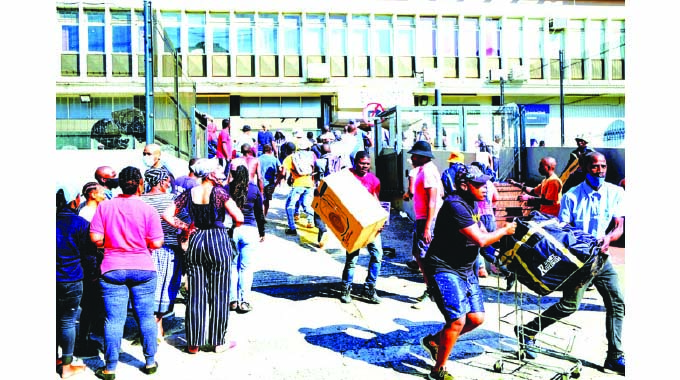Zim to feel heat from SA riots

Tawanda Musarurwa
Zimbabwe’s industries will likely feel the pinch of the violent demonstrations and looting unfolding in South Africa, its largest trading partner, as trade channels get clogged and supply chains disrupted.
The violent demonstrations, looting and arson over the incarceration of former president Jacob Zuma, which started KwaZulu-Natal, have been rapidly spread to other parts of South Africa.
Other than the impact on Africa’s biggest economy, the insurrection has negatively impacted regional trade due to disruptions of operations at the Durban Port, Richards Bay Port, logistics and freight companies.
The Durban Port in particular, is the main gateway to the Southern Africa Development Community (Sadc) region. The port is connected to the inland countries via the North-South Corridor.
Durban port handles up to 31,4 million tonnes of cargo annually and is the fourth largest container terminal in the southern hemisphere.
Importantly, Durban Port is one of the major delivery terminals used by Zimbabwean importers and exporters as an international gateway.
Official figures show that South Africa is Zimbabwe’s biggest source of and route for raw materials destined for the country’s industry, followed by Europe at 13 percent, and China at 11 percent.
Observers opine that the huge dependency on South Africa leaves local industry exposed to any negative development in its southern neighbour.
“Our industries are exposed by the developments in South Africa. Covid-19 and the current developments in South Africa drive further home the need for us to strengthen and deepen our value chains,” said the Confederation of Zimbabwe Industries (CZI).
An analysis of available data shows that local primary producers, as well as food and beverages manufacturers will perhaps be hit hardest by ongoing developments in the South Africa.
According to a CZI report titled ‘Raw Material Import Exposure for Zimbabwean Industries’, 80 percent of Zimbabwean companies in the agriculture and horticulture sectors source their raw materials from or through South Africa.
And in terms of the quantum of raw materials utilised by players in these sectors, 73 percent were imported, while the balance (27 percent) is procured locally.
The report also shows that South Africa is the major source of imported raw materials for local drink, tobacco and beverages producers, although imported raw materials account for 35 percent of their requirements.
Observers in South Africa have also warned of food insecurity issues as a result of the demonstrations.
“In the case of trade, the current disruptions weigh even more heavily on businesses in the agriculture sector and farmers. On average, 75 percent of the country’s grains are transported by road annually,” wrote Wandile Sihlobo from the University of Witwatersrand.
“These are largely exported through the Durban harbour. The same is true for imported food products such as rice, wheat and palm oil, among other products.
“The volumes are also large for horticulture, specifically citrus, a leading exportable agricultural product in South Africa.
The burning of trucks on the roads and the blocked routes to the ports will prove costly to businesses and harm South Africa’s reputation as a global supplier in various value chains.”
These “broader value chains” could also extend to other areas of the Zimbabwean economy, given that South Africa is also Zimbabwe’s biggest export market.
South Africa accounts for over 70 percent of Zimbabwe’s exports.
In this regard, it is largely expected that the latter’s primary producers, namely mining companies; agricultural and horticultural players will be hit if trade routes remain clogged.
According to an earlier analysis by trade expert Taku Fundira for Tralac, “South Africa’s with Zimbabwe mirrors that of a developed country vs developing country trade profile wherein South Africa (developed) imports mainly primary, low value natural resource-based products and exports to Zimbabwe (developing) largely value-added manufactured products.”
He added: “75 percent of South Africa’s imports are mainly mineral products with another 23 percent mainly agricultural products. Exports on the other hand are quite diversified ranging from machinery; mineral fuels; vehicles; plastic products; electrical equipment among others; the bulk of which are value added products.”
Zimbabwe National Chamber of Commerce (ZNCC) chief executive Takunda Mugaga has estimated that the Zimbabwean economy could lose around US$30 million if the demonstrations continue for a period of a week.
The events in South Africa have again highlighted the need for Zimbabwe to boost and diversify its manufacturing output, as well as expand its import and export markets.











Comments